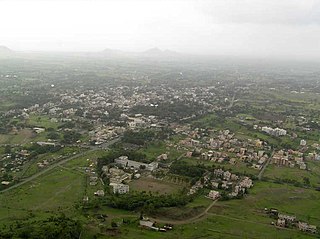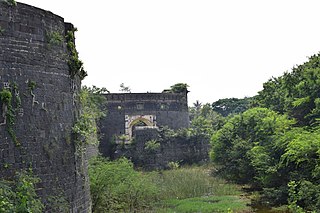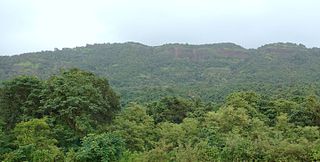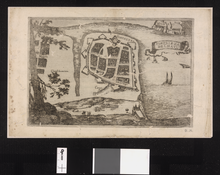Korlai Portuguese is an Indo-Portuguese creole based on the Portuguese language, spoken by approximately 1,000 inhabitants of the Korlai village at the Korlai fort, a former possession of the Portuguese in Goa and Bombay. Their speech is referred to as Korlai creole, Korlai Portuguese, Kristi or Nɔw-ling by the speakers themselves, which translates to "our language" in the creole. The speakers are a part of a very close-knit community, and refer to themselves as the Kristi community bound by their affiliation to the Christian denomination, of Roman Catholicism in India. Korlai is situated in the Raigad district of the Konkan division named after the Colaba fort, 150 kilometers south of Mumbai (Bombay), in Maharashtra, India. The speakers are of a homogenous Roman Catholic pocket in an area otherwise dominated by Konkani Muslim and Hindu Marathi-Konkani speaking inhabitants.

Sinhagad is an ancient hill fortress located at around 49 km southwest of the city of Pune, India.
Revdanda is a village near Alibaug, Raigad District, Maharashtra. It is the site of the medieval 'Chaul harbor'.

Fort Vasai is a ruined fort of the town of Vasai (Bassein), Konkan Division, Maharashtra, India. The structure was formally christened as the Fort of St Sebastian in the Indo-Portuguese era. The fort is a monument of national importance and is protected by the Archaeological Survey of India.

Junnar is a city in the Pune district of the Indian state of Maharashtra. The city has history dating back to the first millennium. The nearby fort of Shivneri was the birthplace of Maratha king Shivaji, the founder of the Maratha Empire. Junnar was declared the first tourism taluka in Pune district by the government of Maharashtra on 9 January 2018.
Murud is a town and a municipal council in Raigad district in the Indian state of Maharashtra. Situated at a distance of 150 km (93 mi) from Mumbai, Murud is a tourist destination. The Palace of Nawab is located in Murud. The palace was built in 1885 for administration purposes. The palace is still owned by the descendants of the Nawab and is a private property.

Kolaba Fort located at Alibag beach is an old fortified maritime base in Alibag, Konkan, India. It is situated in the sea at a distance of 1–2 km from the shores of Alibag, 35 km south of Mumbai, in the Konkan region of Maharashtra, India. It is a popular tourist destination and a protected monument.

Raigad, seen in the Raigad district of Maharashtra, India, is a hill fort located in the city of Mahad. It is one of the strongest fortress on the Deccan Plateau and was historically referred to as Rairee or Rairy fort.

Purandar Fort is a mountain fort in Pune district in Western Indian state of Maharashtra, India. The fort stands at 1,374 metres (4,508 ft) above the sea level in the Western Ghats, 50 kilometres (31 mi) to the southeast of Pune.

Panhala fort, is located in Panhala, 20 kilometres northwest of Kolhapur in Maharashtra, India. It is strategically located looking over a pass in the Sahyadri mountain range which was a major trade route from Bijapur in the interior of Maharashtra to the coastal areas. Due to its strategic location, it was the centre of several skirmishes in the Deccan involving the Marathas, the Mughals and the British the grand son's of chhatrapati shivaji maharaj East India Company, the most notable being the Battle of Pavan Khind. Here, the queen regent of Kolhapur, Tarabai Ranisaheb, spent her formative years. Several parts of the fort and the structures within are still intact. It is also called as the 'Fort of Snakes' as it is zigzagged in shape.

Karnala Fort is a hill fort in Raigad district, Maharashtra, India, about 10 km from Panvel city. Currently it is a protected place lying within the Karnala Bird Sanctuary. It was a place of strategic importance since it overlooked the Bor pass, which connected the Konkan coast to the interior of Maharashtra on the main trade route between these areas.

The Ahmednagar Fort is a fort located close to the Bhingar Nala near Ahmednagar in Maharashtra state western India. It was the headquarters of the Ahmednagar Sultanate. In 1803, it was taken by the British during the Second Anglo-Maratha War. It was used as a prison during the British Raj. Currently, the fort is under the administration of the Armoured Corps of the Indian Army.

Vijaydurg, the oldest fort on the Sindhudurg coast, was constructed during the regime of Raja Bhoja II of the Shilahar dynasty and restructured by Shivaji.

Avchitgad is a fort located in the Sahyadri ranges of Maharashtra. The fort is situated near Roha in the Raigad district. At the base of this fort is a village called Medha and Padam - Kharapti.

The Maratha Navy was the naval wing of the armed forces of the Maratha Confederacy, which existed from around the mid-17th century to the mid-18th century in the Indian subcontinent.

Surgad, is a hill fort located in a spur, fragmented from the Sahyadri ranges of Maharashtra. The fort is situated near Roha, next to the village of Vaijanath in the Raigad district. This fort was an observation fort, which guarded the trade route along the Kundalika river from Sudhagad to Revdanda fort.

Shirgaon Fort / Shirgao Fort is a fort located 6.5km from Palghar, in Palghar district, of Maharashtra. This fort is in very good condition. The outer walls, steps, parapets, bastions etc. in solid masonry are in excellent order and worth seeing. The fort is located in the Shirgaon village.
Hatgad Fort is a fort located 71 km (44 mi)from Nashik, Nashik district, of Maharashtra. The base village is Hatgad on the Nashik-Saputara Road. The nearest town is Saputara, which is 6 km from Hatgad village. It is a historic monument located in Maharashtra, India, south of the hill station of Saputara and near the border with Gujarat. It was built by the Maratha king Shivaji and is located at an elevation of about 3,600 feet. The way to reach the fort is through a trekking route via a narrow rocky path and car also go up to the stairs of fort. A statue of Lord Shivling is placed on the top of the fort.
Sarjekot Fort is an old military fortification in India. it is situated very close to the Malvan. It is located in the Arabian Sea close to the Malvan town in Sindhudurg District of Maharashtra state.

The Maratha–Portuguese War of 1683–1684 refers to the Maratha invasion of the Portuguese-controlled portions of Goa and the Bombay area of Konkan. The conflict between the Maratha Confederacy and the Portuguese in Goa and Bombay, continued on various fronts in between 1683–1684.































